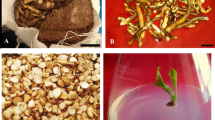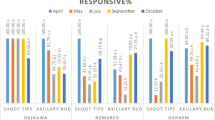Abstract
Walnut (Juglans regia L.) is one of the most economically important nut crops and one of the more difficult to micropropagate. Initiation and maintaining contamination-free shoot cultures is difficult for many species especially for woody plants. Cultivars of walnut from field collections exhibited severe microbial and fungal contamination when standard initiation procedure was used. An alternative disinfection procedure was designed and tested to reduce the microbial contamination. One-yr-old shoots of walnut cultivars Kogylnichanu, Milotai 10, Peschansky, and Xin 2 were cut in the field in February 2021. Cuttings of 30 to 40 cm long were surface disinfested and were put into jars with water to force bud expansion. After 2 wk, the swollen dormant buds were excised from the stem, surface disinfected in 0.1% mercuric chloride for 10 min, washed with sterile water, and placed into test tubes with Driver and Kuniyuki medium (DKW) with and without Plant Preservative Mixture (PPM). Addition of PPM (0.2% v/v) to the initial medium reduced the number of contaminated explants on average for all cultivars from 67.8 to 37.3% and increased the percentage of green shoots from 2.2 to 12.6%. With the combined treatment (shaking explants in 5% (v/v) PPM followed by 0.2% (v/v) PPM in the initial medium), 21.7% visually clean shoots were obtained. These shoots were indexed on 523 detection medium, with 87.5% found to be bacteria-free and suitable for cryopreservation and for producing healthy walnut planting material.




Similar content being viewed by others
References
Amiri ME, Gharati S (2012) Influence of medium composition on multiplication of walnut (Juglans regia L.) growth. J Med Plants Res 6:1482–1485
Anonymous (2022) Rooted Cuttings - Walnut Scion & Rootstock Improvement (ucanr.edu). The University of California – Davis Website. https://walnutrootstock.ucanr.edu/WIP/Propagation/cuttings/. Accessed 19 May 2022
Demenko VI (2005) Problems and possibilities of micropropagation of garden plants. Cult Initiation Proc TSHA 2:48–58 (in Russian)
Driver JA, Kuniyuki AH (1984) In vitro propagation of Paradox walnut rootstock. HortScience 19:507–509
George MW, Tripepi RR (2001) Plant Preservative Mixture™ can affect shoot regeneration from leaf explants of chrysanthemum, European birch, and rhododendron. HortScience 36:768–769
Gotea R, Gotea I, Sestras RE, Vahdati K (2012) In vitro propagation of several walnut cultivars. Horticulture 69:167–171
Hand CR, Wada N, Stockwell V, Reed BM (2016) Node position influences viability and contamination in hazelnut shoot explants. In Vitro Cell Dev Biol - Plant 52:580–589
Ho WJ, Huang YK, Huang WW, Huang YC, Chung JP (2021) Effective in vitro culture using dormant bud of nodal sections from a mature Acacia tree. In Vitro Cell Dev Biol – Plant. https://doi.org/10.1007/s11627-021-10235-8
Kaluzna M, Mikicińsk A, Sobiczewski P, Zawadzka M, Zenkteler E, Orlikowska T (2013) Detection, isolation, and preliminary characterization of bacteria contaminating plant tissue cultures. Acta Agrobot 66:81–92
Lakin GF (1990) Biometrics: a manual for biological specialties of universities, 4th edn. Vysshaya Shkola, Moscow (in Russian)
Leslie C, McGranahan G (1992) Micropropagation in Persian walnut (Jugans regia L.) In: Bajaj YPS (ed) Biotechnology in agriculture and forestry, 18: high-tech and micropropagation II, Springer-Verlag, Berlin, pp136–150
Licea-Moreno RJ, Contreras A, Morales AV, Urban I, Daquinta M, Gomez L (2015) Improved walnut mass micropropagation through combined use of phloroglucinol and FeEDDHA. Plant Cell Tiss Org Cult 123:143–154
Licea-Moreno RJ, Fira A, Chokov G (2020) Micropropagation of valuable walnut genotypes for timber production: new advances and insights. Ann Silvic Res 44:5–13
Orlikowska T, Nowak K, Reed B (2017) Bacteria in the plant tissue culture environment. Plant Cell Tiss Org Cult 128:487–508
Orlikowska T, Zawadzka M, Zenkteler E, Sobiczewski P (2012) Influence of the biocides PPM™ and Vitrofural on bacteria isolated from contaminated plant tissue cultures and on plant microshoots grown on various media. J Hortic Sci Biotechnol 87:223–230
Reed BM, Tanprasert P (1995) Detection and control of bacterial contaminants of plant tissue cultures. A review of recent literature. Plant Tissue Cult Biotechnol 1:137–142
Reed BM, Mentzer J, Tanprasert P, Yu X (1998) Internal bacterial contamination of micropropagated hazelnut: identification and antibiotic treatment. Plant Cell Tiss Org Cult 52:67–70
Seker MG, Sah I, Kirdök E, Ekinci H, Ciftçi YÖ, Akkaya Ö (2017) A hidden plant growth promoting bacterium isolated from in vitro cultures of fraser photinia (Photinia × fraseri). IJAB 19:1511–1519
Statista. The Statistics Portal. https://www.statista.com/statistics/675974/walnut-production-worldwide-by-country. Accessed 17 March 2022
Tekielska D, Peňázová E, Kovács T, Křižan B, Čechová J, Eichmeier A (2019) Bacterial contamination of plant in vitro cultures in commercial production detected by high-throughput amplicon sequencing. Acta Univ Agric Silvic Mendel Brun 67:1005–1014
Thomas P, Agrawal M, Bharathkumar CB (2017) Use of Plant Preservative Mixture™ for establishing in vitro cultures from field plants: experience with papaya reveals several PPM™ tolerant endophytic bacteria. Plant Cell Rep 36:1717–1730
Vahdati K, Leslie C, Zaman Z, McGranaham G (2004) In vitro-grown shoots from mature trees of three Persian walnut cultivars. HortScience 39:324–327
Vahdati K, Razaee R, Mirmasoomi M (2009) Micropropagation of some dwarf and early mature walnut genotypes. Biotechnol 8:171–175
Viss PR, Brooks EM, Driver JA (1991) A simplified method for the control of bacterial contamination in woody plant tissue culture. In Vitro Cell Dev Biol 27:42
Yegizbayeva TK, García-García S, Yausheva TV, Kairova M, Apushev AK, Oleichenko SN, Licea-Moreno RJ (2021) Unraveling factors affecting micropropagation of four Persian walnut varieties. Agronomy 11:1417–1434
Yu X, Reed BM (1995) A micropropagation system for hazelnuts (Corylus species). HortScience 30:120–123
Funding
This study was financially supported by the Ministry of Education and Science, Republic of Kazakhstan (Grant No. AP08855758).
Author information
Authors and Affiliations
Corresponding author
Ethics declarations
Conflict of Interest
The authors declare no competing interests.
Rights and permissions
About this article
Cite this article
Kushnarenko, S., Aralbayeva, M., Rymkhanova, N. et al. Initiation pretreatment with Plant Preservative Mixture™ increases the percentage of aseptic walnut shoots. In Vitro Cell.Dev.Biol.-Plant 58, 964–971 (2022). https://doi.org/10.1007/s11627-022-10279-4
Received:
Accepted:
Published:
Issue Date:
DOI: https://doi.org/10.1007/s11627-022-10279-4




